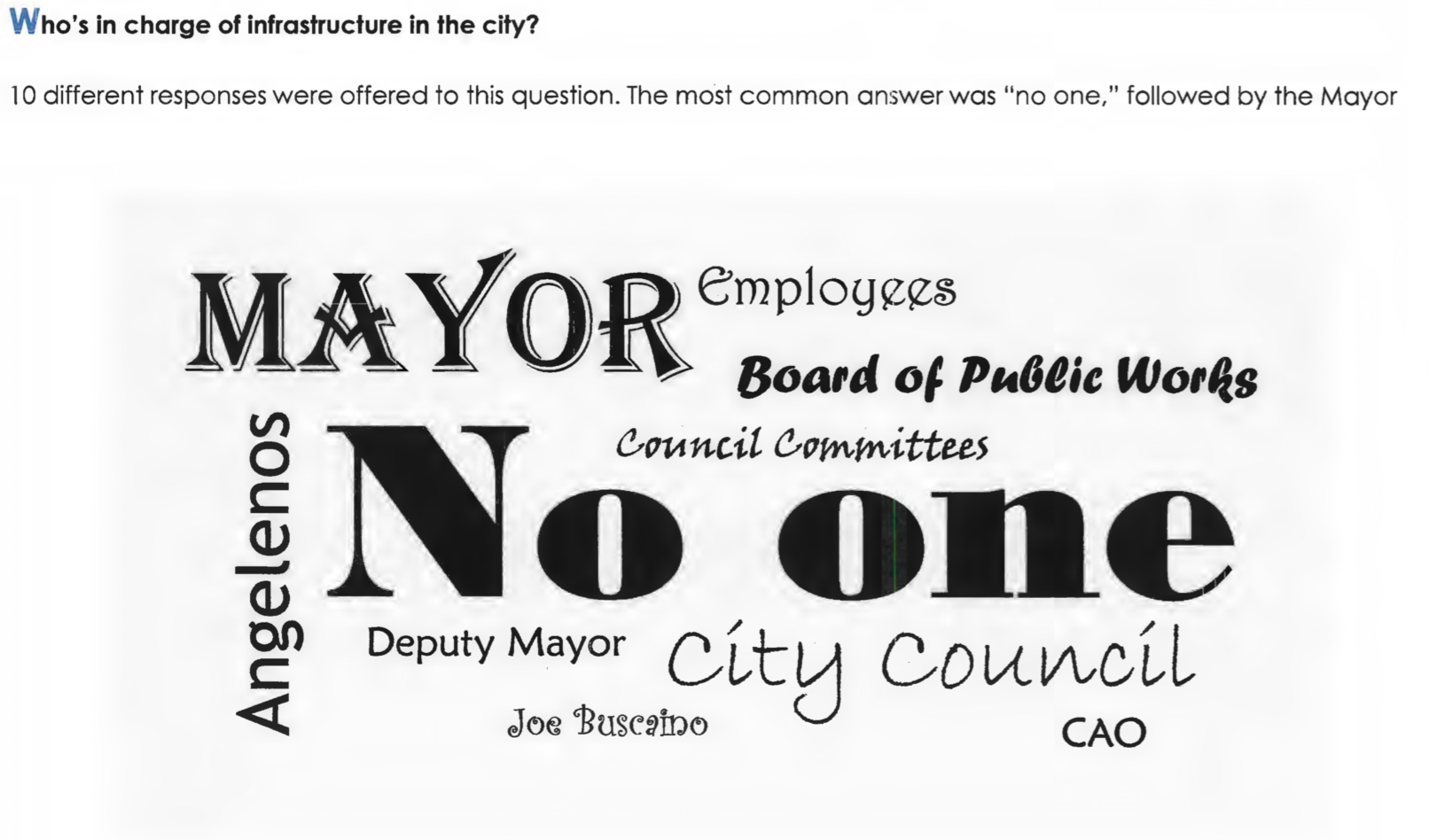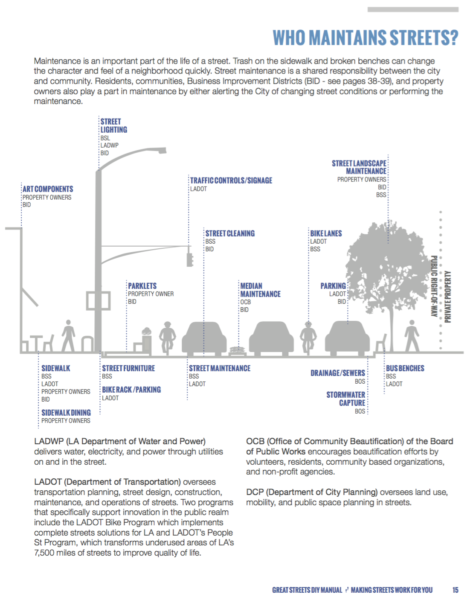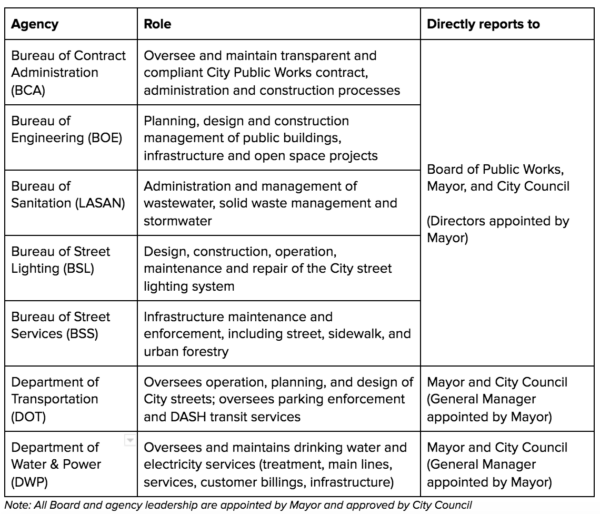The following post is in response to a report issued by the CAO that will be presented to the Public Works and Gang Reduction City Council committee on 12/6/17 at 1pm. Find committee agenda (Item #2) and submit comment here.
My street needs fixing. Now what?
Have you ever wondered how to get your sidewalk repaired in the City of Los Angeles? Or how to get a new crosswalk painted? Or get a street tree planted? Many people may not know: each of these city services is currently available–but through three separate and autonomous city agencies*.
Our built environment has a direct impact on our public health, safety, and opportunity. We rely on public infrastructure to get to to daily destinations like work, school, places of worship, medical appointments, and home. We rely on public infrastructure to cook, manage waste, and illuminate spaces at night. The maintenance and service delivery of our public infrastructure shapes the quality-of-life of city residents.
Source: DIY Great Streets Manual, Mayor’s Office
So who do I call for street repairs and maintenance?
In an effort to demonstrate Los Angeles street jurisdiction, the above image illustrates the mosaic of Los Angeles City jurisdictions that currently oversee and maintain our public right-of-way (all of the public space from property lines on one side of the street to property lines on the other). As many as 11 separate City agencies are responsible for a certain component of our streetscape. It is understandably confusing. And it is no wonder most residents do not know where to start when they need to request basic city services, maintenance, or repairs.
The table below outlines the seven infrastructure agencies of the City of Los Angeles. Each agency has their own executive leadership and mission statement. It should be noted that the Department of Transportation and Department of Water & Power are each standalone city departments with an executive General Manager. The five bureaus below a) together comprise the Department of Public Works; b) are each led by a Director; and c) each report to a Mayor-appointed citizen commission known as the Board of Public Works.
Why are there so many agencies?
The City of Los Angeles is unique from other large U.S. cities. Our city and local government are very decentralized: Los Angeles spans over 450 square miles; we have a strong City Council system (compared to an institutionally weak executive office of the Mayor); and many of our city services departments work separately from each other.
Decentralization of power can promote communication and consensus, rather than focusing absolute power in the hands of one entity. However this process can also create inefficiencies and require excess process, particularly without shared priorities and missions. And when there is poor communication or limited consensus, it can be hard to get anything done. Or know who is responsible for getting the thing done at all.
What does this mean for Los Angeles residents and businesses?
Most people living in cities do not look at the street and identify which department or bureau is in charge of what utility or piece of infrastructure. Most people just want to live in safe, clean, and accessible neighborhoods with basic quality maintenance and city services. And we pay taxes to provide for these services with public dollars.
Los Angeles is the only large city in the country that currently lacks a citywide capital plan. This means that public infrastructure planning, design, and construction is handled separately by different agencies. And when communication and consensus breaks down, this means local government can struggle to provide basic services with an efficient and effective investment of public dollars. A prime example is when we might see utility crews digging up a street that was freshly resurfaced and restriped just a few weeks earlier.
One particular issue of decentralization is the separation of sidewalk repair and maintenance from management of the overall City transportation system. This means that City plans and policies that guide the movement of vehicles that use the roadway (cars, trucks, buses, bicycles) do not take into account the experiences of people walking or rolling.
Our sidewalks are the first part of the public right-of-way we experience when we leave our homes. They determine access to and from our residential and commercial properties, encourage or discourage walking as physical activity or necessary transportation and are one of the most basic city services a local government can provide. When they are in a state of disrepair, they become barriers to resources and opportunity, particularly for our neighbors with disabilities.
How can we improve on this?
The City’s Chief Administrative Officer (CAO) has produced a report, “Evaluation of the State of Street Related Infrastructure Programs in Los Angeles,” written by FUSE fellow Laila Alequresh. The report is a thorough and detailed document that explains the history of Los Angeles infrastructure agencies. Its most impactful recommendation is to move the Department of Transportation into the Department of Public Works as a Bureau, similar to the existing five bureaus described above. The report recommends this as a way to centralize the City’s transportation and street infrastructure agencies, which often rely on each other’s separated work plans to deliver projects.
On paper, this move could make sense. It is logical that the various agencies that work on street and sidewalks should be housed in the same administrative body. This could lead to better project and delivery of services. However, this logic only applies if the inter-bureau coordination and communication of the Public Works Bureaus works well together towards shared missions. The CAO FUSE report does not affirm or deny that there is currently streamlined, successful coordination between Bureaus within the Department of Public Works.
The report also recommends creating an Office of Infrastructure Management within the Board of Public Works. The new office would provide support for transportation and street-related services and strategic delivery of capital projects. This office may be intended to serve the purpose of streamlining and improving inter-bureau coordination and delivery of projects. But an assessment of impact is still needed.
The report will be presented to the Public Works and Gang Reduction council committee this Wednesday December 6 at 1:00pm at City Hall. We will be tracking these recommendations and providing our analysis about how our decentralized city government can improve the public right-of-way and quality-of-life for all of our city residents.
*Sidewalk repair: Bureau of Engineering; crosswalk: Department of Transportation; street tree: Bureau of Street Services. The street image is from a manual created by the Mayor’s Office Great Streets Initiative and available for download at: lagreatstreets.org/diymanual











